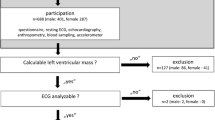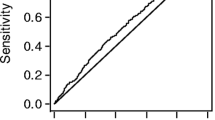Abstract
The question on whether the electrocardiographic criteria are reliable for detection of left ventricular hypertrophy (LVH) and play a role in predicting outcome is open. Answer can only proceed from population-based studies over unselected people followed up for years. In this study, 1,699 subjects from general population underwent echocardiogram and standard electrocardiogram (ECG) codified for LVH with Minnesota code and with other five methods. Other items were also recorded and used as covariables. Left ventricular mass index (LVMI) was 127.6 ± 44.9 g m−2 in men and 120.8 ± 41.2 g m−2 in women, and correlated directly with age in both genders. Prevalence of echocardiographic LVH was 36.6% in men and 53.4% in women. LVMI correlated directly with the Sokolow–Lyon score in both genders at any age, with the Romhilt–Estes, Cornell and RaVL scores in all subjects but elderly men, and with the Lewis score in men and women aged ≤69 years. Sensitivity and the predictive value of electrocardiographic tests, as well as the prevalence of LVH diagnosed with electrocardiographic criteria, were always low. Specificity was high for all the tests, and in particular for the Cornell index. Only when diagnosed with echocardiogram or with the Sokolow–Lyon criterion, LVH was an independent predictor of mortality. We conclude that electrocardiographic tests cannot be used as a surrogate of echocardiogram in detecting LVH in the general population because their positive predictive value (PPV) is unacceptably low. On the contrary, they could replace echocardiography in the follow up and for prediction of outcome, when LVH has previously been correctly diagnosed with other methods.




Similar content being viewed by others
Abbreviations
- CASTEL:
-
CArdiovascular STudy in the ELderly
- CI:
-
Confidence interval
- ECG:
-
Electrocardiogram
- EDIVS:
-
End-diastolic inter-ventricular septum
- FN:
-
False negative
- FP:
-
False positive
- LEOGRA:
-
Last Evidences of Genetic risk factors in the Aged
- LVEDD:
-
Left ventricular end-diastolic diameter
- LVEDPWT:
-
Left ventricular posterior wall thickness
- LVH:
-
Left ventricular hypertrophy
- LVM:
-
Left ventricular mass
- LVMI:
-
Left ventricular mass index
- NPV:
-
Negative predictive value
- PPV:
-
Positive predictive value
- RR:
-
Relative risk
- VN:
-
Very negative
- VP:
-
Very positive
References
Varagic J, Susic D, Frohlich E. Heart, aging and hypertension. Cardiology 2001;16:336–41.
Morales MA, Ferdeghini EM, Piacenti M, Dattolo P, Distante A, Maggiore Q. Age dependency of myocardial structure: a quantitative two-dimensional echocardiographic study in a normal population. Echocardiography 2000;17:201–8.
Fuster V, Danielson MA, Robb RA. Quantization of left ventricular myocardial fiber hypertrophy and interstitial tissue in human hearts with chronically increased volume and pressure overload. Circulation 1977;55:504–8.
Keller K, Wanger KC, Goepfrich M, Stegaru B, Buss J, Heene DI. Morphological quantification and differentiation of left ventricular hypertrophy in hypertrophic cardiomyopathy and hypertensive disease. A two dimensional echocardiographic study. Eur Heart J 1990;11:65–74.
Strauer BE. Structural and functional adaptation of the chronically overloaded heart in arterial hypertension. Am Heart J 1987;114:948–57.
Piccolo E, Raviele A, Delise P, Dainese F, Pascotto P, Totaro G, et al. The role of left ventricular conduction in the electrogenesis of left ventricular hypertrophy. Circulation 1979;59:1044–55.
Casiglia E, Maniati G, Daskalakis C, Colangeli G, Tramontin P, Ginocchio G, et al. Left ventricular hypertrophy in the elderly: unreliability of electrocardiographic criteria in 477 subjects ages 65 years or more. The CArdiovascular STudy in the ELderly (CASTEL). Cardiology 1996;87:429–35.
Casiglia E, Spolaore P, Mormino P, Maschio O, Colangeli G, Celegon L, et al. The CASTEL project (Cardiovascular Study in the Elderly): protocol, study design, and preliminary result of the initial survey. Cardiologia 1991;36:569–76.
Casiglia E, Mazza A, Tikhonoff V, Pavei A, Privato G, Schenal N, et al. Weak effect of hypertension and other classic risk factors in the elderly who have paid their toll. J Hum Hypertens 2002;16:21–31.
Casiglia E, Palatini P. CArdiovascular risk factors in the elderly. J Hum Hypertens 1998;12:575–81.
Casiglia E, Tikhonoff V, Mazza A, Pessina AC. Systolic and pulse hypertension. Aging Health 2005;1:85–94.
Casiglia E, Basso G, Guglielmi F, Martini B, Mazza A, Tikhonoff V, et al. German origin clusters for high cardiovascular risk in an Italian enclave. Int Heart J 2005;46:489–500.
Casiglia E, Tikhonoff V, Mazza A, Rynkiewicz A, Limon J, Caffi S, et al. C-344T polymorphism of the aldosterone synthase gene and blood pressure in the elderly: a population-based study. J Hypertens 2005;23:1991–6.
Casiglia E, Saugo M, Schiavon L, Tikhonoff V, Rigoni G, Basso G, et al. Reduction of cardiovascular risk and mortality. A population-based study. Adv Ther 2006;23:905–20.
Rose GA, Blackburn H, Gillum RF, Prineas RJ. Cardiovascular survey methods, Annes 1: classification of the electrocardiogram for population studies. 2nd ed. Geneva: WHO; 1982.
Sokolow JA, Lyon TP. The ventricular hypertrophy as obtained by unipolar or precordial and limbs lead. Am Heart J 1949;37:161–85.
Romhilt DW, Estes EH. A point-score system for the ECG diagnosis of left ventricular hypertrophy. Am Heart J 1968;75:752–8.
Lewis T. Observation upon ventricular hypertrophy with especial reference to preponderance of one or other chamber. Heart 1914;5:367–72.
Schack JA, Rosemann RH, Katz LN. The aV limb leads in the diagnosis of ventricular strain. Am Heart J 1950;30:697–705.
Kilty SE, Lepeschkin E. Effect of body build on the QRS voltage of the electrocardiogram in normal men. Its significance in the diagnosis of left ventricular hypertrophy. Circulation 1965;31:77–84.
Casale PN, Devereux RB, Kligfield P, Eisenberg RR, Miller DH, Chaudhary BS, et al. Electrocardiographic detection of left ventricular hypertrophy: development and prospective validation of improved criteria. J Am Coll Cardiol 1985;6:572–80.
Casale PN, Devereux RB, Alonso DR, Campo E, Klingfield P. Improved sex-specific criteria of left ventricular hypertrophy for clinical and computer interpretation of electrocardiograms: validation with autopsy findings. Circulation 1987;75:565–72.
Alfakih K, Walters K, Jones T, Ridgway J, Hall AS, Sivananthan M. New gender-specific partition values for ECG criteria of left ventricular hypertrophy. Recalibration against cardiac MRI. Hypertension 2004;44:175–9.
Bemmett DH, Evans DW. Correlation of left ventricular mass determined with echocardiographic voltage measurements. Br Heart J 1974;36:981–7.
Liebson PR, Devereux RB, Horan MJ. Echocardiography in the measurement of left ventricular wall mass. Hypertension 1987;9(Suppl 2):2–5.
Crow SR, Hannan P, Grandits G, Liebson P. Is the echocardiogram an appropriate ECG validity standard for the detection and change in left ventricular size? J Electrocardiol 1996;29(Suppl):248–55.
Devereux RB, Alonso DR, Lutas EM, Gottlieb GJ, Campo E, Sachs I, et al. Echocardiographic assessment of left ventricular hypertrophy: comparison to necropsy findings. Am J Cardiol 1986;63:237–40.
Clémenty J, Bergère P, Bricaud H. Electrocardiography and vectorcardiography in the evaluation of left ventricular hypertrophy due to pressor overload. Eur Heart J 1982;3(Suppl A):37–47.
Devereux RV. Evaluation of cardiac structure and function by echography and other non-invasive techniques. In Laragh JH, Brenner BM editors. Hypertension: pathophysiology, diagnosis and management. New York: Raven Press; 1990. p. 1479–90.
Du Bois D, Du Bois F. A formula to estimate the approximate surface area if height and weight are known. Arch Intern Med 1916;17:863–71.
Hammond IW, Devereux RB, Alderman MH, Lutas EM, Spitzer MC, Crowley JS, et al. The prevalence and correlates of echocardiographic left ventricular hypertrophy among employed patients with uncomplicated hypertension. J Am Coll Cardiol 1986;7:613–8.
Fragola PV, Autore C, Magni G, Albertini M, Pierangeli L, Ruscitti G, et al.. Limitations of the electrocardiographic diagnosis of left ventricular hypertrophy: the influence of left anterior hemiblock and right bundle branch block. Int J Cardiol 1992;34:41–8.
Greener PF, Mayewski RJ, Mushlim AI, Greenland P. Selection and interpretation of diagnostics tests and procedures. Ann Intern Med 1981;94:553–600.
Rifkin RD, Hood WB. Bayesian analysis of electrocardiographic exercise stress testing. N Engl J Med 1977;297:681–6.
Lieb W, Mayer B, Stritzke J, Doering A, Hense H-W, Loewel H, et al. Association of low-grade urinary albumin excretion with left ventricular hypertrophy in the general population The MONICA/KORA Augsburg Echocardiographic Substudy. Nephrol Dial Transplant 2006;21:2780–7.
De Simone G, Kizer JR, Chinali M, Roman MJ, Bella JN, Best LG, Lee ET, Devereux RB, Strong Heart Study Investigators. Normalization for body size and population-attributable risk of left ventricular hypertrophy. Am J Hypertens 2005;18:191–6.
Dawson A, Morris AD, Struthers AD. The epidemiology of left ventricular hypertrophy in type 2 diabetes mellitus. Diabetologia 2005;48:1971–9.
Ferrara LA, Vaccaro O, Cardoni O, Mancini M, Zanchetti A. Arterial hypertension increases left ventricular mass: role of hight blood pressure control. J Hum Hypertens 2004;18:637–42.
Selzer A. The Bayes theorem and clinical electrocardiography. Am Heart J 1981;101:360–3.
Weber JR. Left ventricular hypertrophy: its prime importance as a controllable risk factor. Am Heart J 1988;116:272–9.
Dollar AL, Roberts WC. Usefulness of total 12-lead QRS voltage compared with other criteria for determining left hypertrophy in hypertrophic cardiomyopathy: analysis of 54 patients studied at necropsy. Am J Med 1989;87:377–81.
Chou TC, Scott RC, Booth RW, McWhorter HB. Specificity of the current electrocardiographic criteria in the diagnosis of left ventricular hypertrophy. Am Heart J 1960;60:371–7.
Romhilt DW, Bove KE, Norris RJ, Conyers E, Conradi S, Rowlands DT, et al. A critical appraisal of electrocardiographic criteria for the diagnosis of left ventricular hypertrophy. Circulation 1969;75:752–8.
De Simone G, Schillaci G, Palmieri V, Devereux RB. Should all patients with hypertension have echocardiography? J Hum Hypertens 2000;14:417–21.
Zhou SH, Rautaharju PM, Prineas R, Neaton J, Crow R, Calhoun H, et al. Improved ECG Models for estimation of left ventricular hypertrophy progression and regression incidence by redefinition of criteria for a significant change in left ventricular hypertrophy status. J Electrocardiol 1993;26(Suppl):108–13.
Cuspidi C, Michey I, Meani S, Severgnini B, Fusi V, Salerno M, et al. Trends in hypertension control and left ventricular hypertrophy over three years. Ital Heart J 2002;3:514–9.
Okin PM, Devereux RB, Liu JE, Oikarinen L, Jern S, Kjeldsen SE, et al. Regression of electrocardiographic left ventricular hypertrophy predicts regression of echocardiographic left ventricular mass: the LIFE study. J Hum Hypertens 2004;18:403–9.
Richardson K, Engel G, Yamazaki T, Chun S, Froelicher VF. Electrocardiographic damage scores and cardiovascular mortality. Am Heart J 2005;149:458–63.
Sundström J, Lind L, Ärnlöv J, Zethelius B, Andrén B, Lithell HO. Echocardiographic and electrocardiographic diagnoses of left ventricular hypertrophy predict mortality independently of each other in a population of elderly men. Circulation 2001;103:2346–51.
Kohsaka S, Sciacca RR, Sugioka K, Sacco RL, Homma S, Di Tullio MR. Additional impact of electrocardiographic over echocardiographic diagnosis of left ventricular hypertrophy for predicting the risk of ischemic stroke. Am Heart J 2005;149:181–6.
Author information
Authors and Affiliations
Corresponding author
Rights and permissions
About this article
Cite this article
Casiglia, E., Schiavon, L., Tikhonoff, V. et al. Electrocardiographic criteria of left ventricular hypertrophy in general population. Eur J Epidemiol 23, 261–271 (2008). https://doi.org/10.1007/s10654-008-9234-6
Received:
Accepted:
Published:
Issue Date:
DOI: https://doi.org/10.1007/s10654-008-9234-6




